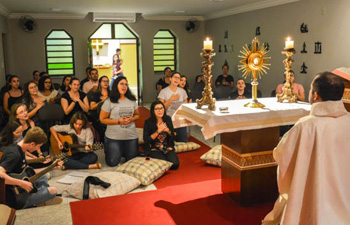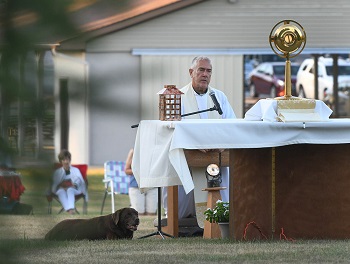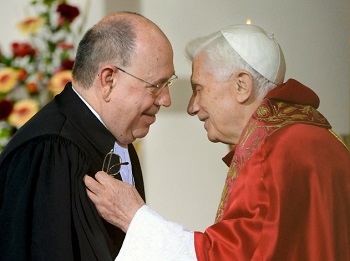Asuntos Tradicionalistas
 |
 |
 |
 |
 |
 |
 |
Misa Dialogada - CXLIV
Una previsible crisis de fe eucarística
La pérdida generalizada de la creencia en la Presencia Real ha sido ampliamente documentada en la famosa Encuesta Pew de Conocimiento Religioso en los Estados Unidos de 2010, en la que se preguntó a los participantes qué creían que “describiría mejor la enseñanza católica” sobre este tema. Los resultados no resultaron sorprendentes.
La gran mayoría de los que se autodenominaban católicos creían que las especies consagradas eran simplemente símbolos de la Presencia de Cristo entre ellos, y la mitad de ellos ni siquiera conocían la enseñanza oficial de la Iglesia sobre la Transubstanciación. Encuestas de seguimiento más recientes no mostraron ninguna mejora significativa en la situación.

 Joseph Ratzinger (como el Papa Benedicto XVI) se dio cuenta de que entre los fieles había una creciente sensación de malestar por la existencia de algo erróneo en las reformas litúrgicas y cambió de postura en lo que respecta a las visitas al Santísimo Sacramento, y comenzó a producir documentos que alababan esta antigua práctica junto con otras formas de adoración eucarística. Un ejemplo se puede encontrar en Sacramentum Caritatis (2007) §§ 67-68.
Joseph Ratzinger (como el Papa Benedicto XVI) se dio cuenta de que entre los fieles había una creciente sensación de malestar por la existencia de algo erróneo en las reformas litúrgicas y cambió de postura en lo que respecta a las visitas al Santísimo Sacramento, y comenzó a producir documentos que alababan esta antigua práctica junto con otras formas de adoración eucarística. Un ejemplo se puede encontrar en Sacramentum Caritatis (2007) §§ 67-68.
Pero para entonces era demasiado poco y demasiado tarde. Después de dos generaciones de reformas posteriores al Vaticano II, es casi imposible borrar los errores que se han arraigado en las mentes de los fieles católicos, tanto clérigos como laicos, o sacudirlos de sus hábitos de pensamiento ahora arraigados.
Un ejemplo de esto último lo encontramos en la reforma de la abstinencia de carne los viernes, que dejó de ser obligatoria: cuando, décadas después, se intentó restablecerla, muchos católicos, acostumbrados desde hacía tiempo a pensar en la Tradición como parte de un pasado muerto, consideraron incomprensible la teología en la que se basaba y simplemente la ignoraron.
De modo similar, los intentos poco entusiastas de reintroducir la Bendición o la Exposición del Santísimo Sacramento en algunas parroquias han quedado en manos de la fortuna. No se puede garantizar que tengan un éxito significativo en la renovación del fervor eucarístico, ya que el clero, en general, ha perdido el sentido de lo sagrado.
 Esto no se puede simplemente restablecer automáticamente o desear que exista sin crear una atmósfera de confusión e incoherencia entre los sacerdotes y las personas que se han acostumbrado a través de la práctica de toda la vida a tratar el Sacramento con falta de respeto.
Esto no se puede simplemente restablecer automáticamente o desear que exista sin crear una atmósfera de confusión e incoherencia entre los sacerdotes y las personas que se han acostumbrado a través de la práctica de toda la vida a tratar el Sacramento con falta de respeto.
En la Bendición de estilo moderno, no hay una disposición consistente en la práctica litúrgica, por lo que se pierde su conexión con la Tradición y la ceremonia pierde su significado. A menudo se improvisa en una variedad de métodos e idiomas, con o sin custodia, utilizando una Hostia grande o pequeña, e incluso se realiza en presencia de personas que hablan entre sí mientras participan en una actividad completamente no relacionada.
De manera similar con la Exposición, las disposiciones no son propicias para la adoración. En algunas iglesias, la custodia se coloca en una habitación sin adornos sobre una mesa baja de café, al mismo nivel que los fieles. No se proporcionan reclinatorios. Los fieles se sientan en sillas que están dispuestas en dos filas para que puedan mirarse directamente entre sí en lugar de mirar al Santísimo Sacramento.
Es tal la indiferencia que rodea a la práctica moderna que, cuando la última persona se va, el sacramento expuesto queda desatendido. Esta situación, que ahora es una práctica aceptada, habría conmocionado profundamente a los católicos anteriores al Vaticano II, pero se informa con frecuencia de que sucede, especialmente en las iglesias del centro de las ciudades.
La contribución de Ratzinger a la crisis
El prólogo del segundo volumen de la trilogía, Jesús de Nazaret, confirma dónde están los verdaderos intereses de Ratzinger: no en defender la doctrina católica en términos claramente comprensibles, sino en elaborar nuevas formulaciones que confundan a los luteranos y los hagan pensar que su idea de la Eucaristía es fundamentalmente compatible con la doctrina católica, o al menos no demasiado distante de ella.
Un punto importante que hay que destacar es cómo Benedicto trata a los ecumenistas no católicos como iguales, incluso como amigos, en la religión, con la implicación de que no necesitan evangelización en la doctrina católica. En referencia al teólogo luterano Joachim Ringleben, que había publicado recientemente un libro erudito titulado Jesús, Ratzinger lo describió como un “compañero ecuménico” del suyo, y le dio el mismo peso teológico:
“Espero que estos dos libros, tanto en sus diferencias como en sus puntos esenciales comunes, puedan ofrecer un testimonio ecuménico que, en el momento actual y a su manera, pueda servir a la tarea común fundamental de los cristianos”.
 Esta iniciativa conjunta de “ecumenismo” es un ejemplo de cómo la “Nueva Evangelización” adoptada después del Vaticano II reemplazó a la evangelización tradicional que enfatiza la Verdad por sobre la herejía.
Esta iniciativa conjunta de “ecumenismo” es un ejemplo de cómo la “Nueva Evangelización” adoptada después del Vaticano II reemplazó a la evangelización tradicional que enfatiza la Verdad por sobre la herejía.
Siguiendo con el tema de los dos libros, Ratzinger afirmó que “a pesar de los diferentes puntos de vista teológicos, es la misma fe la que está en acción” y que “emerge una profunda unidad en la comprensión esencial de la persona de Jesús y su mensaje”. Pero no es una cuestión de diferentes “puntos de vista”. Al mezclar las creencias católicas y protestantes, nos estaba invitando a creer que lo que en realidad son dos conceptos opuestos de la Fe son simplemente dos percepciones diferentes de la misma realidad.
Sus presuposiciones no están respaldadas por ninguna evidencia de que los protestantes realmente crean en Cristo como Él es en realidad, es decir, en el Santísimo Sacramento. Aunque algunos protestantes creen en lo que llaman la “Presencia Real” en la Eucaristía, no se entiende en el mismo sentido que se entiende en la enseñanza católica. Además, nunca se explicó cómo es posible esta “profunda unidad” entre católicos y protestantes, cuando los protestantes ni siquiera están unidos entre sí. Parece que Ratzinger simplemente la quiso así.
La raíz del problema aquí, como en gran parte de la teología de Ratzinger, reside en el abandono de la metafísica escolástica: habiéndola expurgado conscientemente de su educación filosófica temprana, ya no le sirvió de nada en su carrera intelectual. Este hecho, unido a la política de “ecumenismo” del Vaticano II (que él mismo ayudó a idear en el Concilio) explica lo fácil que le fue dar un crédito indebido a la obra de los teólogos protestantes y ver la creencia de los no católicos en términos favorables irrealistas.
Corpus Christi
En este espíritu, Ratzinger hizo la siguiente observación difamatoria sobre Trento, culpándolo de ofender a los protestantes y de hacer que éstos pusieran en duda la doctrina católica de la Eucaristía:
“El Concilio de Trento concluye sus observaciones sobre el Corpus Christi con algo que ofende a nuestros oídos ecuménicos y que sin duda ha contribuido no poco a desacreditar esta fiesta ante la opinión de nuestros hermanos protestantes. Pero si depuramos su formulación del tono apasionado del siglo XVI, nos sorprenderá algo grande y positivo.”1
La dura crítica de Ratzinger contiene un reproche a la Iglesia Católica por su defensa “apasionada” de su propia fe, al tiempo que concilia a los protestantes que fueron, y siguen siendo, igualmente apasionados en su condena de la devoción católica al Santísimo Sacramento como nada más que superstición e idolatría.
Una verificación de la realidad
La característica más destacada de la carrera eclesiástica de Ratzinger, ilustrada en sus diversos roles oficiales – perito del concilio, profesor, arzobispo, cardenal, prefecto y papa– es que siempre estuvo buscando una “nueva síntesis” de expresión religiosa que incorporara ideas de fuentes externas al catolicismo. Luego combinaba los elementos dispares para formar algo nuevo que, fuera lo que fuese, por definición no sería catolicismo.
Su decisión de rechazar el sistema escolástico por ser “demasiado estrecho” para extender sus alas intelectuales fuera de los confines del particularismo católico tuvo consecuencias desafortunadas. Le impidió defender de manera consistente la verdad y la integridad de la fe católica.
El papa Pío XI había enseñado en Mortalium animos (1928) que hay “una ley de creencia y una fe de cristianos”, y que debemos mantener “las enseñanzas de Cristo íntegras e incorruptas”. Ratzinger creía en una legendaria “unidad profunda” entre todos los que se llaman cristianos. Era inflexible en cuanto a que no debería exigirse la conversión a la Iglesia católica después de las divisiones históricas que dividieron a la cristiandad:
“Esta unidad no significa lo que podría llamarse ecumenismo del retorno: es decir, negar y rechazar la propia historia de fe. ¡Absolutamente no!”2
 En estos tiempos “ecuménicos”, parece haberse olvidado que la ley de la fe (lex credendi) es absoluta y no admite compromisos ni ambivalencias.
En estos tiempos “ecuménicos”, parece haberse olvidado que la ley de la fe (lex credendi) es absoluta y no admite compromisos ni ambivalencias.
Ratzinger, sin embargo, partió de una perspectiva ideológica distorsionada. Formaba parte de una camarilla de teólogos de élite –entre ellos De Lubac, von Balthasar, Congar y Küng– que adoptaron posiciones originalmente forjadas en los años modernistas y condenadas por el Papa Pío X. Todos sus colegas de la “Nueva Teología” compartían su aversión a la Escolástica, que era un formidable obstáculo a la incursión de ideas heréticas en la Iglesia. Consiguieron derribar “murallas” y erigir otras nuevas a partir de sus propias cabezas para apuntalar su “Nueva Teología”.
Ratzinger describió una vez sus propios esfuerzos en el Concilio para burlar a los teólogos escolásticos e impedir que el esquema original sobre la Constitución de la Iglesia viera la luz del día. Una de sus objeciones se refería a la distinción que siempre se había hecho entre quienes eran miembros de la Iglesia y quienes no lo eran.
Pero cuando la verdad entra en conflicto con el “ecumenismo”, la claridad y la honestidad se dejan de lado, y la distinción que él reconoció que estaba “santificada por un largo uso en la teología católica” tendría que ser silenciada. Con referencia al esquema original que se había elaborado con la precisión lingüística y el riguroso análisis conceptual del sistema escolástico, explicó:
“Al deshacerse de esta armadura terminológica, el texto [de reemplazo] adquirió un alcance mucho más amplio. Esto hizo posible una presentación mucho más positiva de la manera en que los cristianos se relacionan con la Iglesia, así como un estatus cristiano positivo para los cristianos separados de Roma”.4
La batalla entre la escolástica y el neomodernismo se libró a nivel oficial en las primeras etapas del Concilio. Considerando el papel de Ratzinger en la desaparición de la escolástica y su dedicación a promover un falso ecumenismo, uno tiene que preguntarse por qué alguien querría renunciar a un método altamente eficiente de comunicar la Verdad por un plato de lentejas ecuménicas.
Continuará ...

La gran mayoría de los que se autodenominaban católicos creían que las especies consagradas eran simplemente símbolos de la Presencia de Cristo entre ellos, y la mitad de ellos ni siquiera conocían la enseñanza oficial de la Iglesia sobre la Transubstanciación. Encuestas de seguimiento más recientes no mostraron ninguna mejora significativa en la situación.

Una Adoración Eucarística progresista; otra aquí; abajo, Una capilla lateral fría y desolada en una iglesiaNovus Ordo

Pero para entonces era demasiado poco y demasiado tarde. Después de dos generaciones de reformas posteriores al Vaticano II, es casi imposible borrar los errores que se han arraigado en las mentes de los fieles católicos, tanto clérigos como laicos, o sacudirlos de sus hábitos de pensamiento ahora arraigados.
Un ejemplo de esto último lo encontramos en la reforma de la abstinencia de carne los viernes, que dejó de ser obligatoria: cuando, décadas después, se intentó restablecerla, muchos católicos, acostumbrados desde hacía tiempo a pensar en la Tradición como parte de un pasado muerto, consideraron incomprensible la teología en la que se basaba y simplemente la ignoraron.
De modo similar, los intentos poco entusiastas de reintroducir la Bendición o la Exposición del Santísimo Sacramento en algunas parroquias han quedado en manos de la fortuna. No se puede garantizar que tengan un éxito significativo en la renovación del fervor eucarístico, ya que el clero, en general, ha perdido el sentido de lo sagrado.

Algunos sacerdotes incluso permiten perros en las celebraciones de adoración completamente no sacras.
En la Bendición de estilo moderno, no hay una disposición consistente en la práctica litúrgica, por lo que se pierde su conexión con la Tradición y la ceremonia pierde su significado. A menudo se improvisa en una variedad de métodos e idiomas, con o sin custodia, utilizando una Hostia grande o pequeña, e incluso se realiza en presencia de personas que hablan entre sí mientras participan en una actividad completamente no relacionada.
De manera similar con la Exposición, las disposiciones no son propicias para la adoración. En algunas iglesias, la custodia se coloca en una habitación sin adornos sobre una mesa baja de café, al mismo nivel que los fieles. No se proporcionan reclinatorios. Los fieles se sientan en sillas que están dispuestas en dos filas para que puedan mirarse directamente entre sí en lugar de mirar al Santísimo Sacramento.
Es tal la indiferencia que rodea a la práctica moderna que, cuando la última persona se va, el sacramento expuesto queda desatendido. Esta situación, que ahora es una práctica aceptada, habría conmocionado profundamente a los católicos anteriores al Vaticano II, pero se informa con frecuencia de que sucede, especialmente en las iglesias del centro de las ciudades.
La contribución de Ratzinger a la crisis
El prólogo del segundo volumen de la trilogía, Jesús de Nazaret, confirma dónde están los verdaderos intereses de Ratzinger: no en defender la doctrina católica en términos claramente comprensibles, sino en elaborar nuevas formulaciones que confundan a los luteranos y los hagan pensar que su idea de la Eucaristía es fundamentalmente compatible con la doctrina católica, o al menos no demasiado distante de ella.
Un punto importante que hay que destacar es cómo Benedicto trata a los ecumenistas no católicos como iguales, incluso como amigos, en la religión, con la implicación de que no necesitan evangelización en la doctrina católica. En referencia al teólogo luterano Joachim Ringleben, que había publicado recientemente un libro erudito titulado Jesús, Ratzinger lo describió como un “compañero ecuménico” del suyo, y le dio el mismo peso teológico:
“Espero que estos dos libros, tanto en sus diferencias como en sus puntos esenciales comunes, puedan ofrecer un testimonio ecuménico que, en el momento actual y a su manera, pueda servir a la tarea común fundamental de los cristianos”.

Benedicto XVI en Erfurt saluda al protestante Nikolaus Schneider después de presentar a Lutero como modelo
Siguiendo con el tema de los dos libros, Ratzinger afirmó que “a pesar de los diferentes puntos de vista teológicos, es la misma fe la que está en acción” y que “emerge una profunda unidad en la comprensión esencial de la persona de Jesús y su mensaje”. Pero no es una cuestión de diferentes “puntos de vista”. Al mezclar las creencias católicas y protestantes, nos estaba invitando a creer que lo que en realidad son dos conceptos opuestos de la Fe son simplemente dos percepciones diferentes de la misma realidad.
Sus presuposiciones no están respaldadas por ninguna evidencia de que los protestantes realmente crean en Cristo como Él es en realidad, es decir, en el Santísimo Sacramento. Aunque algunos protestantes creen en lo que llaman la “Presencia Real” en la Eucaristía, no se entiende en el mismo sentido que se entiende en la enseñanza católica. Además, nunca se explicó cómo es posible esta “profunda unidad” entre católicos y protestantes, cuando los protestantes ni siquiera están unidos entre sí. Parece que Ratzinger simplemente la quiso así.
La raíz del problema aquí, como en gran parte de la teología de Ratzinger, reside en el abandono de la metafísica escolástica: habiéndola expurgado conscientemente de su educación filosófica temprana, ya no le sirvió de nada en su carrera intelectual. Este hecho, unido a la política de “ecumenismo” del Vaticano II (que él mismo ayudó a idear en el Concilio) explica lo fácil que le fue dar un crédito indebido a la obra de los teólogos protestantes y ver la creencia de los no católicos en términos favorables irrealistas.
Corpus Christi
En este espíritu, Ratzinger hizo la siguiente observación difamatoria sobre Trento, culpándolo de ofender a los protestantes y de hacer que éstos pusieran en duda la doctrina católica de la Eucaristía:
“El Concilio de Trento concluye sus observaciones sobre el Corpus Christi con algo que ofende a nuestros oídos ecuménicos y que sin duda ha contribuido no poco a desacreditar esta fiesta ante la opinión de nuestros hermanos protestantes. Pero si depuramos su formulación del tono apasionado del siglo XVI, nos sorprenderá algo grande y positivo.”1
La dura crítica de Ratzinger contiene un reproche a la Iglesia Católica por su defensa “apasionada” de su propia fe, al tiempo que concilia a los protestantes que fueron, y siguen siendo, igualmente apasionados en su condena de la devoción católica al Santísimo Sacramento como nada más que superstición e idolatría.
Una verificación de la realidad
La característica más destacada de la carrera eclesiástica de Ratzinger, ilustrada en sus diversos roles oficiales – perito del concilio, profesor, arzobispo, cardenal, prefecto y papa– es que siempre estuvo buscando una “nueva síntesis” de expresión religiosa que incorporara ideas de fuentes externas al catolicismo. Luego combinaba los elementos dispares para formar algo nuevo que, fuera lo que fuese, por definición no sería catolicismo.
Su decisión de rechazar el sistema escolástico por ser “demasiado estrecho” para extender sus alas intelectuales fuera de los confines del particularismo católico tuvo consecuencias desafortunadas. Le impidió defender de manera consistente la verdad y la integridad de la fe católica.
El papa Pío XI había enseñado en Mortalium animos (1928) que hay “una ley de creencia y una fe de cristianos”, y que debemos mantener “las enseñanzas de Cristo íntegras e incorruptas”. Ratzinger creía en una legendaria “unidad profunda” entre todos los que se llaman cristianos. Era inflexible en cuanto a que no debería exigirse la conversión a la Iglesia católica después de las divisiones históricas que dividieron a la cristiandad:
“Esta unidad no significa lo que podría llamarse ecumenismo del retorno: es decir, negar y rechazar la propia historia de fe. ¡Absolutamente no!”2

Pío XI condenó el mismo ecumenismo que Benedicto XVI promovería décadas después
Ratzinger, sin embargo, partió de una perspectiva ideológica distorsionada. Formaba parte de una camarilla de teólogos de élite –entre ellos De Lubac, von Balthasar, Congar y Küng– que adoptaron posiciones originalmente forjadas en los años modernistas y condenadas por el Papa Pío X. Todos sus colegas de la “Nueva Teología” compartían su aversión a la Escolástica, que era un formidable obstáculo a la incursión de ideas heréticas en la Iglesia. Consiguieron derribar “murallas” y erigir otras nuevas a partir de sus propias cabezas para apuntalar su “Nueva Teología”.
Ratzinger describió una vez sus propios esfuerzos en el Concilio para burlar a los teólogos escolásticos e impedir que el esquema original sobre la Constitución de la Iglesia viera la luz del día. Una de sus objeciones se refería a la distinción que siempre se había hecho entre quienes eran miembros de la Iglesia y quienes no lo eran.
Pero cuando la verdad entra en conflicto con el “ecumenismo”, la claridad y la honestidad se dejan de lado, y la distinción que él reconoció que estaba “santificada por un largo uso en la teología católica” tendría que ser silenciada. Con referencia al esquema original que se había elaborado con la precisión lingüística y el riguroso análisis conceptual del sistema escolástico, explicó:
“Al deshacerse de esta armadura terminológica, el texto [de reemplazo] adquirió un alcance mucho más amplio. Esto hizo posible una presentación mucho más positiva de la manera en que los cristianos se relacionan con la Iglesia, así como un estatus cristiano positivo para los cristianos separados de Roma”.4
La batalla entre la escolástica y el neomodernismo se libró a nivel oficial en las primeras etapas del Concilio. Considerando el papel de Ratzinger en la desaparición de la escolástica y su dedicación a promover un falso ecumenismo, uno tiene que preguntarse por qué alguien querría renunciar a un método altamente eficiente de comunicar la Verdad por un plato de lentejas ecuménicas.
Continuará ...
- J. Ratzinger, La fiesta de la fe: enfoques para una teología de la liturgia, San Francisco: Ignatius Press, 1986, p. 130. La edición original en alemán fue Das Fest des Glaubens: Versuche zur Theologie des Gottesdienstes, Einsiedeln: Johannes Verlag, 1981. Es muy significativo que la editorial Johannes Verlag fuera propiedad del colega de Ratzinger, el p. Urs von Balthasar.
- Benedicto XVI, "Viaje apostólico a Colonia con ocasión del Encuentro Ecuménico de la Jornada Mundial de la Juventud", 19 de agosto de 2005. En el mismo discurso, Benedicto XVI aclaró su razón para perseguir el "ecumenismo": “He querido conscientemente seguir las huellas de dos de mis grandes predecesores: el Papa Pablo VI, que hace más de cuarenta años firmó el Decreto conciliar sobre el ecumenismo Unitatis redintegratio, y el Papa Juan Pablo II, que hizo de él un documento Documentar la inspiración para su actividad.”
- J. Ratzinger, Theological Highlights of Vatican II, Nueva York: Paulist Press, 1966, p. 66.
- Ibíd.
Publicado el 15 de noviembre de 2024

______________________
______________________
 Volume I |
 Volume II |
 Volume III |
 Volume IV |
 Volume V |
 Volume VI |
 Volume VII |
 Volume VIII |
 Volume IX |
 Volume X |
 Volume XI |
 Special Edition |






